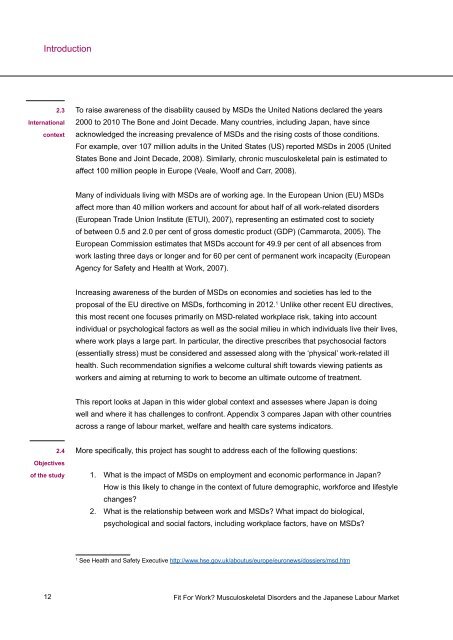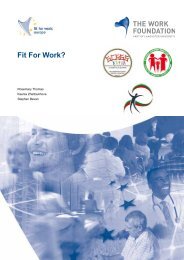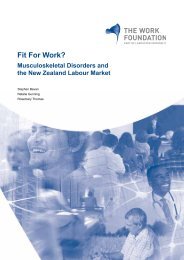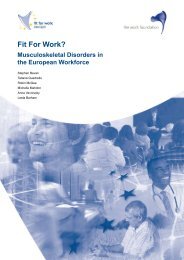English version - Fit for Work Europe
English version - Fit for Work Europe
English version - Fit for Work Europe
Create successful ePaper yourself
Turn your PDF publications into a flip-book with our unique Google optimized e-Paper software.
Introduction<br />
12<br />
2.3<br />
International<br />
context<br />
2.4<br />
Objectives<br />
of the study<br />
To raise awareness of the disability caused by MSDs the United Nations declared the years<br />
2000 to 2010 The Bone and Joint Decade. Many countries, including Japan, have since<br />
acknowledged the increasing prevalence of MSDs and the rising costs of those conditions.<br />
For example, over 107 million adults in the United States (US) reported MSDs in 2005 (United<br />
States Bone and Joint Decade, 2008). Similarly, chronic musculoskeletal pain is estimated to<br />
affect 100 million people in <strong>Europe</strong> (Veale, Woolf and Carr, 2008).<br />
Many of individuals living with MSDs are of working age. In the <strong>Europe</strong>an Union (EU) MSDs<br />
affect more than 40 million workers and account <strong>for</strong> about half of all work-related disorders<br />
(<strong>Europe</strong>an Trade Union Institute (ETUI), 2007), representing an estimated cost to society<br />
of between 0.5 and 2.0 per cent of gross domestic product (GDP) (Cammarota, 2005). The<br />
<strong>Europe</strong>an Commission estimates that MSDs account <strong>for</strong> 49.9 per cent of all absences from<br />
work lasting three days or longer and <strong>for</strong> 60 per cent of permanent work incapacity (<strong>Europe</strong>an<br />
Agency <strong>for</strong> Safety and Health at <strong>Work</strong>, 2007).<br />
Increasing awareness of the burden of MSDs on economies and societies has led to the<br />
proposal of the EU directive on MSDs, <strong>for</strong>thcoming in 2012. 1 Unlike other recent EU directives,<br />
this most recent one focuses primarily on MSD-related workplace risk, taking into account<br />
individual or psychological factors as well as the social milieu in which individuals live their lives,<br />
where work plays a large part. In particular, the directive prescribes that psychosocial factors<br />
(essentially stress) must be considered and assessed along with the ‘physical’ work-related ill<br />
health. Such recommendation signifies a welcome cultural shift towards viewing patients as<br />
workers and aiming at returning to work to become an ultimate outcome of treatment.<br />
This report looks at Japan in this wider global context and assesses where Japan is doing<br />
well and where it has challenges to confront. Appendix 3 compares Japan with other countries<br />
across a range of labour market, welfare and health care systems indicators.<br />
More specifically, this project has sought to address each of the following questions:<br />
1. What is the impact of MSDs on employment and economic per<strong>for</strong>mance in Japan?<br />
How is this likely to change in the context of future demographic, work<strong>for</strong>ce and lifestyle<br />
changes?<br />
2. What is the relationship between work and MSDs? What impact do biological,<br />
psychological and social factors, including workplace factors, have on MSDs?<br />
1 See Health and Safety Executive http://www.hse.gov.uk/aboutus/europe/euronews/dossiers/msd.htm<br />
<strong>Fit</strong> For <strong>Work</strong>? Musculoskeletal Disorders and the Japanese Labour Market







